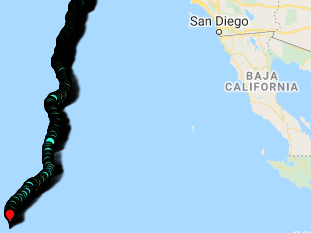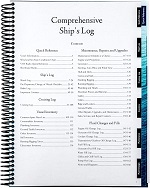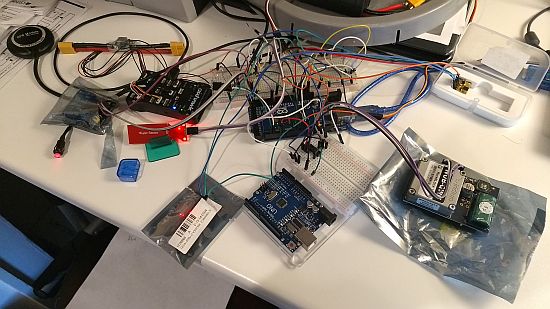Magnetic Coupling Failure and LoCARB Recovered
One of the things I loved to see when reading about other boats that have failed their autonomous voyages (running the Micro-transat challenge), was if the creators ever recovered their boats and discovered the problem that caused the failure. Despite the fact that LoCARB has been launched and recovered 3 times, that joy of finding out what went wrong is surprisingly still intact. On April 18th 2021, LoCARB was launched for the third time from El Granada in Half Moon Bay. What I hoped to be the final launch ended up to be another failure, another period of waiting for the boat to drift back to shore, and thankfully… another successful recovery!
The entire route that LoCARB took while drifting back to shore and landing at Pomponio State Beach. The gap in the route is when I rebooted the Pixhawk autopilot to set a new waypoint for Martins Beach just slightly north of Pomponio St. Beach. I found that serial communications between the Pixhawk and Arduino gets interrupted unless the Arduino serial line is reset after the Pixhawk is up and running (I just reset the Arduino to fix this). I later set a waypoint for Pomponio St. Beach after I realized that the currents weren’t cooperating, and thankfully the boat was able to reach it!
Here are some obligatory recovery pics:
It took a bit of a hike to finally reach LoCARB, but the beach was beautiful, albeit desolate and lonely feeling.

LoCARB looked so serene sitting there wistfully. Still too far away to see the propeller condition fully.

Was the prop still intact? Yep. Same with the blue tape last minute 5200 repair for a hole I didn’t see until day before launch!
Everything was still in place…Worst case scenario! That means the coupling inside had failed, AGAIN!
So what happened?
The newer, beefier, stronger, and better magnetic coupling failed…but not in a way I thought it would.
It failed because of heat.
Building LoCARB has been full of surprises, but none more so than finding the fun ways the materials I use, fail. Carbon fiber rods are brittle and splinter easily when cracked, epoxy will turn mushy if not fully cured and exposed to acetone vapor over a pro-longed period of time, and now… that running an RC motor generates enough heat to melt ABS plastic. SIGH.
After recovering LoCARB (an ordeal in and of itself), I found myself cutting the coupling apart (again!), and discovering (to my delight, oh yes…), that the magnetic coupling had melted and sheared off from a collision of some sort.
You can see the torque that was exerted upon the motor-side coupling by looking at the 3d print lines.
The portion of the coupling which remained attached to the motor.
See the rust on the magnets? Water had seeped in from what I believe is the waterproof barrier (unable to test/confirm that though). The rust may have been from my freshwater testing of the coupling as one day in the water shouldn’t have created rust so quickly?
Why do I believe a collision or strong force was involved? Because the capsize counter incremented by 1, and GPS lock was lost for 2 updates (1 hour). Afterwards, there was a bump in RPM. This RPM was indicative of a decoupled motor state which did not slow down even after trying multiple lower throttles.
What I think happened: I believe the boat hit some rough water and may have actually flipped upside down, disorienting the autopilot, causing it to freak out and allowing the prop to spin quickly while out of water. Upon the propellers re-entry into the water, it meets enough resistance to break the coupling free from the motor. It does so because after being exposed to +160F heat for one hour, the plastic has reached softening temps (I guess).
This is a condensed view of the updates I received from LoCARB from 10:37am – 11:37am (the second duplicate is for the iridium estimated GPS data on the tracker map). As you can see, at 10:37am everything is great at throttle speed 2. I then manually send a high throttle of 5. I then see that things are great for 30 minutes despite being +158F…(remember this is just ambient air temp in the motor enclosure, not actual motor metal temp). The next 30 minutes (1 hour after sending a throttle of 5) I see that RPM has exceeded the typical speed, which is now in a decoupled state.
Is a low cost magnetic coupling possible?
YES, I believe it is. But would require integrating multiple materials into the design to support the mating surface of the motor-side magnetic coupling. An alternative is having a motor-side coupling machined or printed in metal, but that again increases the total cost of the project.
One could also run the motor at a lower speed (to keep temps under 100F), to keep the coupling from melting…But what’s the fun of that right? Oh right, were trying to go the distance, not break water speed records for boats that look like a child built it…Yes this is a valid option, but one that I don’t find particularly exciting. This is however, the best option for cost effectiveness though.
As such, I believe that I could potentially redesign the current version (v2) of my coupling with one which integrates fiberglass or aluminum cut and drilled to further strengthen the motor-side coupling and run the motor slightly slower, but I don’t really have the motivation to.
What’s the next design?
Because this experiment is all about “what if’s” and cost, I am going to simplify in a way that most may believe is taking a step backwards from the magnetic coupling approach. I’m going to try to connect the propeller shaft directly to the motor with some sort of aluminum/steel adapter coupling, and have the entire motor submerged in saltwater (yes yes I know, the steel shaft of the motor and the aluminum stuck together will probably corrode terribly in salt water).
I have so many questions. What can I apply to the components to slow the corrosion? How will I attach the shaft to the motor (since there doesn’t seem to be any readily available off the shelf options)? How long will the motor last before the bearings, windings, or solder joints fail?
Maybe that’s what brought me to this project in the first place. I don’t have any real world knowledge on how long it will practically last. But maybe I just need to do it to find out.
And just like that, LoCARB is exciting again.
Oh and…
- Now that LoCARB has been tested and run out in the ocean again, I believe that I have gotten the Pixhawk navigation bugs and settings fully sorted out.
- FYI, I also believe my motor monitoring function needs to account for decoupling RPM based on target RPM and not a hardcoded RPM. In its current state, the function will not accurately detect a decoupling condition if on a lower throttle so don’t use the rpm > 1700 in the code. Instead use autothrottle_rpm + bias (such as 200) as a dynamic trigger. This will adjust dynamically based on the currently selected throttle.











Your post is amazing! and full of interesting data
Thank you so much!